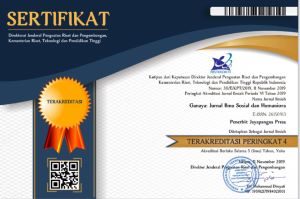Nilai Pendidikan Agama Hindu Dalam Tari Baris Jangkang Desa Pakraman Pelilit Nusa Penida
DOI:
https://doi.org/10.37329/cetta.v4i4.3100Keywords:
Inheritance Value, Baris Jangkang, Nusa PenidaAbstract
Indonesia has a lot of cultural wealth in the form of art, including music, sound, painting, sculpture and dance. The dances that developed in Indonesia have various types and are unique in each region. Culture or art that develops in Indonesia, especially in Bali, has an important role, both as a supporter of religious rituals and as a medium of entertainment. Sacred dance faces challenges in the current era, mainly due to the increasing influence of tourism and the ever-growing dynamics of Balinese society. This gives rise to debate and negotiation regarding which dances should be reserved for sacred events and which may be performed as tourism entertainment. In response to this, it is important to inherit and preserve sacred dances that are danced in religious ritual ceremonies because they have many spiritual and philosophical values. Even though some dance arts have experienced extinction, it turns out that there are still several dance arts that remain strong and strong among the people of Nusa Penida. One example is the Baris Jangkang Dance which can be found in Desa Pakraman Pelilit, Nusa Penida, Klungkung. This research uses a descriptive qualitative method, where the data that is processed and analyzed is presented in words arranged into a sentence. The history of this dance comes from the story of a person from Desa Pakraman Pelilit who had supernatural powers named I Nyoman Kulit. This dance contains educational values from a Hindu perspective. These values should be passed on to society as a basis or guide for life so that they have a clear direction and purpose in life. It has religiosity values from the aspect of the purity of the dancers and also the symbols of the clothing used. Has the value of education as a unifier of society.References
Bandem, I. M. (1996). Etnologi Tari Bali. Yogyakarta: Kanisius.
Colorafi, K. J., & Evans, B. (2016). Qualitative Descriptive Methods in Health Science Research. Health Environments Research and Design Journal, 9(4), 16–25.
Haes, P. E. (2021). Pelestarian Budaya dalam Tari Wali Krama Murwa pada Tradisi Usaba Sambah di Desa Pesedahan Karangasem. Ideas: Jurnal Pendidikan, Sosial, Dan Budaya, 7(3), 101.
Karmini, N. W., & Paramartha, W. (2019). Nilai-Nilai Pendidikan Dalam Tari Sanghyang Manik Geni Di Pura Serayu Desa Adat Canggu, Kuta Utara-Badung. Mudra Jurnal Seni Budaya, 34(3), 341-348.
Linggih, I. N., & Sudarsana, I. K. (2020). The dynamics of Rejang renteng dance in Bali as an intangible cultural heritage of the world. Space and Culture, India, 7(4), 45–58.
Pemayun, A. G. P. (2018). Ekonomi Kreatif dan Kearifan Lokal dalam Pembangunan Pariwisata Berkelanjutan di Bali. Denpasar: Universitas Pendidikan Nasional.
Pratama, I. G., & Soewito, B. M. (2015). Perancangan Film Dokumenter” Selonding; Nyanyianmu Semangat Kami” Sebagai Kebudayaan Khas Desa Tenganan Pegringsingan Bali. Jurnal Sains Dan Seni ITS.
Rahmadani, S., & Hasrul, H. (2021). Program Dinas Kebudayaan Sumatera Barat dalam Melestarikan Budaya Minangkabau. Journal of Civic Education, 4(2), 163-172.
Rianta, I. M., Santosa, H., & Sariada, I. K. (2019). Estetika Gerak Tari Rejang Sakral Lanang Di Desa Mayong, Seririt, Buleleng, Bali. Mudra Jurnal Seni Budaya, 34(3), 285-393.
Sariada, I. K., & Ginaya, G. (2019). Tektekan calonarang at puri anyar kerambitan. International Journal of Linguistics, Literature and Culture, 5(3), 48–60.
Suardika, N. (2018). Pementasan Tari Kakelik pada Upacara Piodalan di Pura Gede Pemayun Desa Pakraman Banyuning Kecamatan Buleleng Kabupaten Buleleng (Kajian Bentuk, Fungsi, dan Makna). Purwadita: Jurnal Agama dan Budaya, 2(1).
Surahman, S. (2013). Dampak Globalisasi Media Terhadap Seni dan Budaya Indonesia. LONTAR: Jurnal Ilmu Komunikasi, 2(1).
Tuchman-Rosta, C. (2014). From ritual form to tourist attraction: Negotiating the transformation of classical cambodian dance in a Changing World. Asian Theatre Journal, 31(2), 524–544.
Vaismoradi, M., Turunen, H., & Bondas, T. (2013). Content analysis and thematic analysis: Implications for conducting a qualitative descriptive study. Nursing and Health Sciences, 15(3), 398–405.
Wantiasih, A. (2013). Pewarisan Nilai-Nilai Kepahlawanan Melalui Pementasan Baris Jangkang di Desa Pakraman Pelilit Nusa Penida Klungkung Bali. Widya Winayata: Jurnal Pendidikan Sejarah, 1 (2).
Downloads
Published
How to Cite
Issue
Section
License
Copyright (c) 2021 Ni Putu Ida Lasyana Dewi, Ni Wayan Sariani Binawati

This work is licensed under a Creative Commons Attribution-ShareAlike 4.0 International License.
An author who publishes in the Cetta : Jurnal Ilmu Pendidikan agrees to the following terms:
- Author retains the copyright and grants the journal the right of first publication of the work simultaneously licensed under the Creative Commons Attribution-ShareAlike 4.0 License that allows others to share the work with an acknowledgement of the work's authorship and initial publication in this journal
- Author is able to enter into separate, additional contractual arrangements for the non-exclusive distribution of the journal's published version of the work (e.g., post it to an institutional repository or publish it in a book) with the acknowledgement of its initial publication in this journal.
- Author is permitted and encouraged to post his/her work online (e.g., in institutional repositories or on their website) prior to and during the submission process, as it can lead to productive exchanges, as well as earlier and greater citation of the published work (See The Effect of Open Access).
Read more about the Creative Commons Attribution-ShareAlike 4.0 Licence here: https://creativecommons.org/licenses/by-sa/4.0/.





